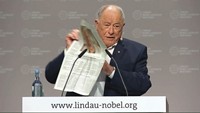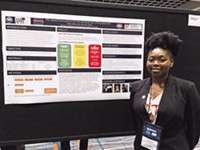Advertisement
Grab your lab coat. Let's get started
Welcome!
Welcome!
Create an account below to get 6 C&EN articles per month, receive newsletters and more - all free.
It seems this is your first time logging in online. Please enter the following information to continue.
As an ACS member you automatically get access to this site. All we need is few more details to create your reading experience.
Not you? Sign in with a different account.
Not you? Sign in with a different account.
ERROR 1
ERROR 1
ERROR 2
ERROR 2
ERROR 2
ERROR 2
ERROR 2
Password and Confirm password must match.
If you have an ACS member number, please enter it here so we can link this account to your membership. (optional)
ERROR 2
ACS values your privacy. By submitting your information, you are gaining access to C&EN and subscribing to our weekly newsletter. We use the information you provide to make your reading experience better, and we will never sell your data to third party members.
Nobel Prize
Nobel Laureates Unveil Secrets Of Scientific Success
Young chemists gathered in Germany to get careers advice from winners
by Alex Scott
August 12, 2013
| A version of this story appeared in
Volume 91, Issue 32

For one week this July, Lindau, a medieval town on a small island on Lake Constance, in southern Germany, was host to more than 600 young scientists from around the world. The scientists, a mix of graduate students and postdoctoral fellows from about 80 countries, made the journey to listen to and learn from 34 Nobel Laureates, their heroes from the world of science.

The meeting focused specifically on chemistry. The laureates are drawn to the annual, weeklong meeting not just to lecture but to pass on advice and guidance on how to approach a career in science. While the laureates meeting in Lindau this year have an average age of 77, the young scientists are in their 20s and 30s.
The meeting had a profound effect on some young scientists including Ju Yuel Baek, a South Korean carbohydrate chemist who works at the Max Planck Institute of Colloids & Interfaces, in Germany. Before the Lindau meeting, Baek, 36, didn’t think he could become a laureate. But after just a couple of days in Lindau, he had changed his mind. “I think I can,” he told C&EN.
Although Baek gained a new outlook on science from his participation in the Lindau meeting there is a danger that the laureates could miss the mark with other young scientists because the advice they offer could be dated or even irrelevant.
“In research I am not sure it’s a good idea for the young scientists to listen to the advice of their elders. We get stuck in ruts,” said 80-year-old Robert F. Curl Jr., the Kenneth S. Pitzer-Schlumberger Professor of Natural Sciences and University Professor Emeritus at Rice University, in Houston. Curl became a Nobel Laureate for his codiscovery of fullerenes, the carbon cage compounds, in 1996.
There are clear differences between the era when Curl was setting out as a young scientist in the 1950s and that of today’s young scientists. “A recurrent theme of the talks has to be the big difference between when I was coming up as a young person and these people. When I came up you were hoping to discover something. Nowadays you’ve got to predict what you are going to discover, which is a pretty high hurdle,” said Curl with a wry smile.
Research funding is also now harder to secure and its focus more restricted compared with recent decades. “Research is meant to generate something for mankind,” Curl said. “I don’t have any objection at all to directed research, but on the other hand because of political reasons there is less and less opportunity for research that is driven by curiosity.”
Robert H. Grubbs, professor of chemistry at California Institute of Technology, who was awarded the 2005 Nobel Prize in Chemistry for developing the metathesis method in organic synthesis, is also acutely aware of the greater opportunities for funding research that were available to him in the post-Sputnik era compared with what is on offer to young scientists today.
Help For The Unemployed
Many chemists are still struggling to find jobs. The American Chemical Society offers special discounts and career assistance to its unemployed members.
National dues: Waiveda
National meeting registration: Free
Regional meeting registration: Reduced fees
ACS Leadership Development System: Reduced rateb
ACS Short Courses: 50% discount
ACS Member Insurance Program: Life insurance premiums deferred
For a full listing of benefits for unemployed members, visit www.acs.org/unemployed.
Free career assistance tools for all ACS members:
Virtual Career Fair
ACS Webinars
ACS Careers blog
Personal career consulting
Access to the ACS Network (www.acs.org/acsnetwork)
For more information (www.acs.org/careers)
a Apply for a waiver by contacting ACS with your name and member number via e-mail at service@acs.org or by calling (800) 333-9511 or (614) 447-3776. Dues may be waived for up to two years for unemployed members in good standing. b Enroll in one online course for $25, get three online courses free.
But whatever apparent incompatibilities there may be between the laureates and the young scientists, the reality is that the laureates don’t just make the event work; they make it fizz, pop, and come alive.
There is a high-energy buzz around the conference hall. Talk with the likes of Curl, Grubbs, and Ada E. Yonath, who was awarded the Nobel Prize in Chemistry in 2009, and it quickly becomes apparent that they have perspective on scientific investigation that transcends their own fields of expertise and own eras. Many of the laureates may be advanced in age, but watch them on the Lindau stage and it is obvious that they also have an extraordinary ability to convey their passion for science with clarity, enthusiasm, and no little energy.
Typically, the laureates gave their Lindau lectures in a way that laid out their scientific journey: how curiosity led them to look closely at anomalies, how serendipity played a role in their work, and how the research that led to their Nobel Prizes in many cases was a relatively small part of a long and varied career.
While delivering scientific lectures, the laureates offered nuggets of advice on how to approach certain scientific challenges. One of the threads of advice running through many of the presentations was that the young scientists should go where their curiosity takes them. “There are many messages, but all boil down to one: Go into science if you are curious and have passion for it. If not, find something else. It’s not that the whole world has to become scientists,” said Yonath, whose studies of the structure and function of the ribosome have since led to approaches for overcoming antibiotic resistance. Yonath is only the fourth woman to be awarded the Nobel Prize in Chemistry, along with Marie Curie, Curie’s daughter Irène Joliot-Curie, and the English chemist Dorothy Crowfoot Hodgkin.
A key piece of advice from Curl was, “Overcome your fear. This is something I always had difficulty doing.” He added that the late Richard E. Smalley, Curl’s research colleague with whom he shared the 1996 Nobel Prize in Chemistry, was “fearless” in his approach to science.
“You’ve got to let the kids know they can pull it off too,” said Grubbs, 71, whose lecture style is fast paced and packed with ideas and philosophy about science. Blink while Grubbs is lecturing and you miss a gem.
Meanwhile, in a way that typified the laureates’ blend of science and philosophy, Jean-Marie Lehn, who shared the Nobel Prize in Chemistry in 1987 for developing molecules that recognize each other, urged the young scientists to be proactive: “The book of dreams is not just to be read but to be written,” he said. He also likened the discovery of scientific evidence to the 19th-century French artist Auguste Rodin’s carving of a sculpture from stone.
Whether or not the young scientists take up the advice is of course another matter. The audience at Lindau appeared rapt. Ask 10 or so young scientists, as C&EN did, whether they benefited from the event and all will tell you that it was a positive—if not perspective-changing—experience.
For Evelyn Auyeung, a 25-year-old Ph.D. student at Northwestern University working in the field of nanoparticle assembly into superlattices, the meeting was revelatory. The most important advice for Auyeung was dispatched by Martin Chalfie, who was one of three awarded the Nobel Prize in Chemistry in 2008. During a discussion session, Chalfie recalled how early in his career he left research to become a teacher only to give scientific research a second go. “When I was in college, although I enjoyed research, I was unsure of whether science was the right career path for me. It is reassuring for me to know that a successful career in science is possible even for those who did not play with the proverbial chemistry kit as children,” Auyeung said.
Auyeung rejects the notion that the laureates’ thinking is stuck in another era. “Their insight into how they’ve adapted remains valuable to young researchers today,” she said. “At Lindau, we learned that there is no easy or straightforward path to success. The biggest thing I gained from Lindau is perspective,” she added.
Vera Krewald, a 26-year-old German Ph.D. student, also found the Lindau meeting provided something extra. Meeting other young scientists and listening to laureates talking on a broad range of topics reinforced Krewald’s perspective on her own career. It “somehow confirmed to me that I made the right choice in taking up computational chemistry and spectroscopy,” she said.
Bert Sakmann, a cell physiologist who was awarded the Nobel Prize in Physiology or Medicine in 1991, is the only person in the event’s 63-year history to have also attended the Lindau lectures as a young scientist. Even if none of this year’s young scientists follow in Sakmann’s footsteps, the Lindau meeting succeeded in encouraging them to be the best they can be.




Join the conversation
Contact the reporter
Submit a Letter to the Editor for publication
Engage with us on Twitter